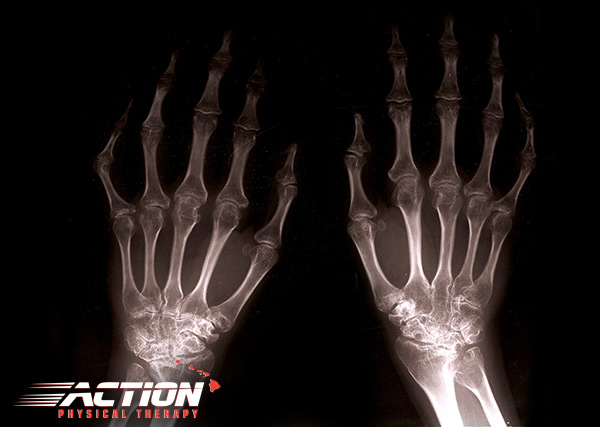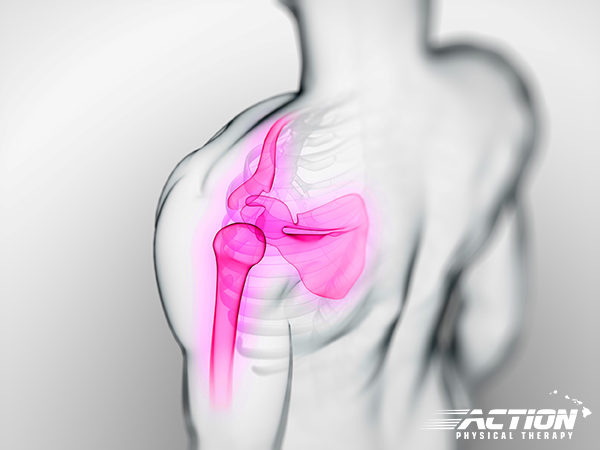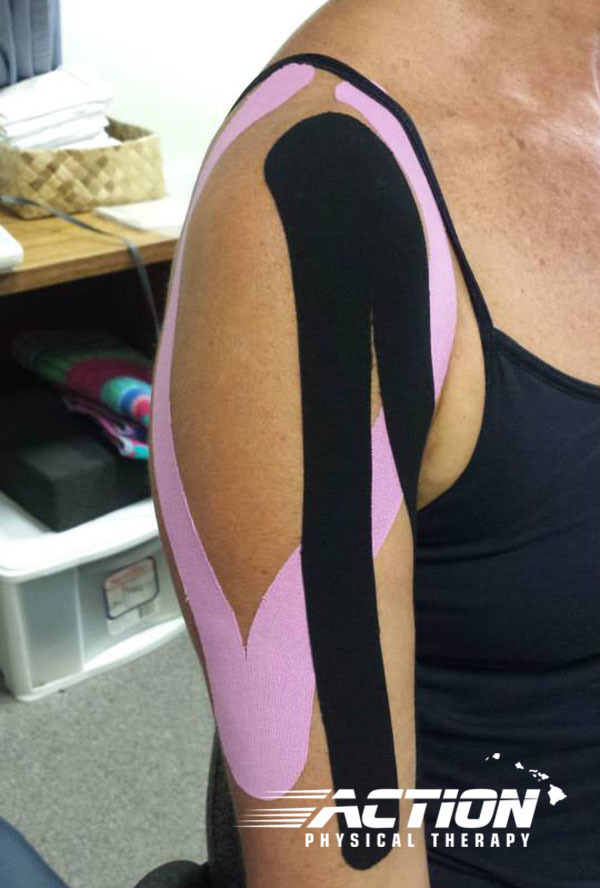Kauai Physical Therapy Blog
Home of Action Physical Therapy: Kauai's Premier Physical Therapy and Personal Fitness Clinic
Body Parts
Scapulothoraticic Bursitis, or as most people call it, “My shoulder hurts.”
The shoulder is a complicated and often over-used joint prone to various pain-causing issues. Between swelling of the bursa, bony abnormalities and insufficient musculature, the shoulder can become a painful and noisy joint. Sound familiar? The first step to healing and returning to pain-free movement is see your P.T.

Motion in the shoulder depends on adequate coordination of the concave scapula on the convex thoracic wall by the periscapular musculature. Incongruence, which has several possible causes, such as bony abnormalities, insufficient muscular control and the thickening and scarring of connective tissue may result in a painful grating sound or sensation produced by friction between bone and cartilage during movement.
If you are interested in learning more read here or contact Action PT today.
Why Do Joints Pop and Crack?
Do you crack your knuckles? Have you ever wondered why they make a popping, cracking, grinding, or snapping sound? SciShow explains what really causes those popping sounds your joints.

The space between the joints increases, causing the gases dissolved in the synovial fluid to form microscopic bubbles. These bubbles merge into large bubbles which then get popped by additional fluid which rushes in to fill the enlarged space.
Click here to watch a short video we found through the Richard Dawkins Foundation Web Site.
Chronic Neck Pain
A recent study reveals that an effective exercise regimen and its components regarding frequency, intensity, time and type (FITT) will improve Chronic Neck Pain.

Chronic Neck Pain (CNP) is treated by many therapists with exercise therapy, but what delivers the best results? According to a recent study published by Elsevier Inc. / American Congress of Rehabilitation Medicine, the objective was to identify the most effective components in an active exercise physiotherapy treatment intervention for CNP based on the frequency, intensity, time, and type (FITT) exercise method.
The study revealed that education and exercise training has the most beneficial effect on reducing pain and improving function and quality of life in patients with CNP. It was also noted that targeting deep neck flexors through strength training has positive effects on quality of life when combined with endurance and aerobic training. Progress was seen in patients that performed 30-60 minutes exercise sessions at least three times per week for 6-12 weeks.
Click here to view the article posted on www.anatomy-physiotherapy.com’s web site.
Are you doing the perfect pull-up?
Using proper technique for all exercises will help you prevent injury and get more out of the movement. Here’s a few tips from coreperformance.com about how to perform a perfect pull-up.

Have you ever wondered if you are doing a pull-up properly? The pull-up is one of the best upper body exercises and provides you with the greatest benefits to your back and upper body. It’s functional, versatile, and easy to throw into a circuit. That’s not to say it’s easy to do right. Pull ups are one of the hardest exercises you can do, well if you do it right.
Here are a few key points to perfecting the pull-up.
• Hang loose.
• Get a grip.
• Stay still.
• Focus.
• Stay tight.
• Keep control.
Click here to read the full article, “Q&A: The Perfect Pull-Up”
How Women Can Strengthen Their Hips to Prevent Injury.
It is one of the most overlooked muscles, but it is an important one. Mark Verstegen, president and founder of Core Performance, shares some basic exercises that will activate the hip muscles and help improve your external and internal hip rotation movement.

The next time you workout, add a couple of these exercises to your routine. Not only will will help you prevent hip pain, back pain, knee pain or injuries, but will help you look great.
1. Quadruped Hip Abduction
2. Single-Leg Glute Bridge
3. External Hip Raise
4. Lateral Band Walk
5. Rotational Medicine Ball Throw
Shoulder Impingement
Motor control retraining exercises for shoulder impingement: effects on function, muscle activation and biomechanics in young adults.
There is limited evidence motor control and strengthening exercises are effective in patients with subacromial impingement syndrome (SIS). The purpose of this study was to investigate the effectiveness of scapular motor control retraining exercises on pain and function outcomes as well as kinematic and neurophysiological parameters.
16 young adults with SIS and 16 healthy age and sex matched individuals were included. Subjects completed several patient reported outcome measures and a testing procedure consisting of arm elevation to 90 degrees in the sagittal, frontal and scapular plane while data was collected using surface electromyography and using a 3D motion analysis system.
After a 10 week motor control intervention including exercises for learning optimal scapular coordination and selective strengthening of the scapular muscles, and manual therapy techniques commonly used in clinical practice, immediate improvements in pain and function were present. Moreover, muscle recruitment patterns were altered significantly, leading to more adequate scapular kinematics. > From: Worsley et al., J Shoulder Elbow Surg 22 (2013) e11-e19. Published in Europe PMC.
- Visit the Pubmed summary for more information or click here for the free full text version.
- Reposted from www.anatomy-physiotherapy.com
Kinesiology Taping
Taping for impingement with long head biceps tendon involvement. Get it done right at Action Physical Therapy – Kauai

Kinesiology taping is a taping technique applied over muscles to reduce pain and inflammation, eliminate swelling and bruising, support muscles, and aid with muscle contraction while an injury is healing. Kinesiology tape provides support as well as healing without restricting range of motion or blood flow. Although the media has primarily associated kinesiology taping with athletes, the majority of its applicants are non athletes. Kinesiology taping can be used for treating a variety of conditions such as carpal tunnel syndrome, back pain, knee pain, shoulder conditions, hamstring injuries, and rotator cuff injuries. It can be an important part of our patient’s post-injury or postoperative recuperation and our physical therapists have seen great improvements in their patients rehabilitation throughout the use of kinesiology tape. Both of our therapists, Ginger and Steve, are skilled in the use and application of this important rehabilitative tool.
How to Reduce Back Pain From Cycling | Play Better | Core Daily | Core Performance
 How to Reduce Back Pain From Cycling
How to Reduce Back Pain From Cycling
via How to Reduce Back Pain From Cycling | Play Better | Core Daily | Core Performance.
 “The success and popularity of the Tyler Twist led us to develop and evaluate an exercise for golfer’s elbow,” lead research author Timothy Tyler, PT, MS, ATC, said in the release. “The Tyler Twist, a novel exercise using the TheraBand FlexBar, was shown to significantly improve strength and reduce pain for individuals with chronic tennis elbow. This new golfer’s elbow exercise, dubbed the Reverse Tyler Twist, also employs a FlexBar and was found to be effective at reducing the pain for patients suffering from golfer’s elbow.”
“The success and popularity of the Tyler Twist led us to develop and evaluate an exercise for golfer’s elbow,” lead research author Timothy Tyler, PT, MS, ATC, said in the release. “The Tyler Twist, a novel exercise using the TheraBand FlexBar, was shown to significantly improve strength and reduce pain for individuals with chronic tennis elbow. This new golfer’s elbow exercise, dubbed the Reverse Tyler Twist, also employs a FlexBar and was found to be effective at reducing the pain for patients suffering from golfer’s elbow.”

